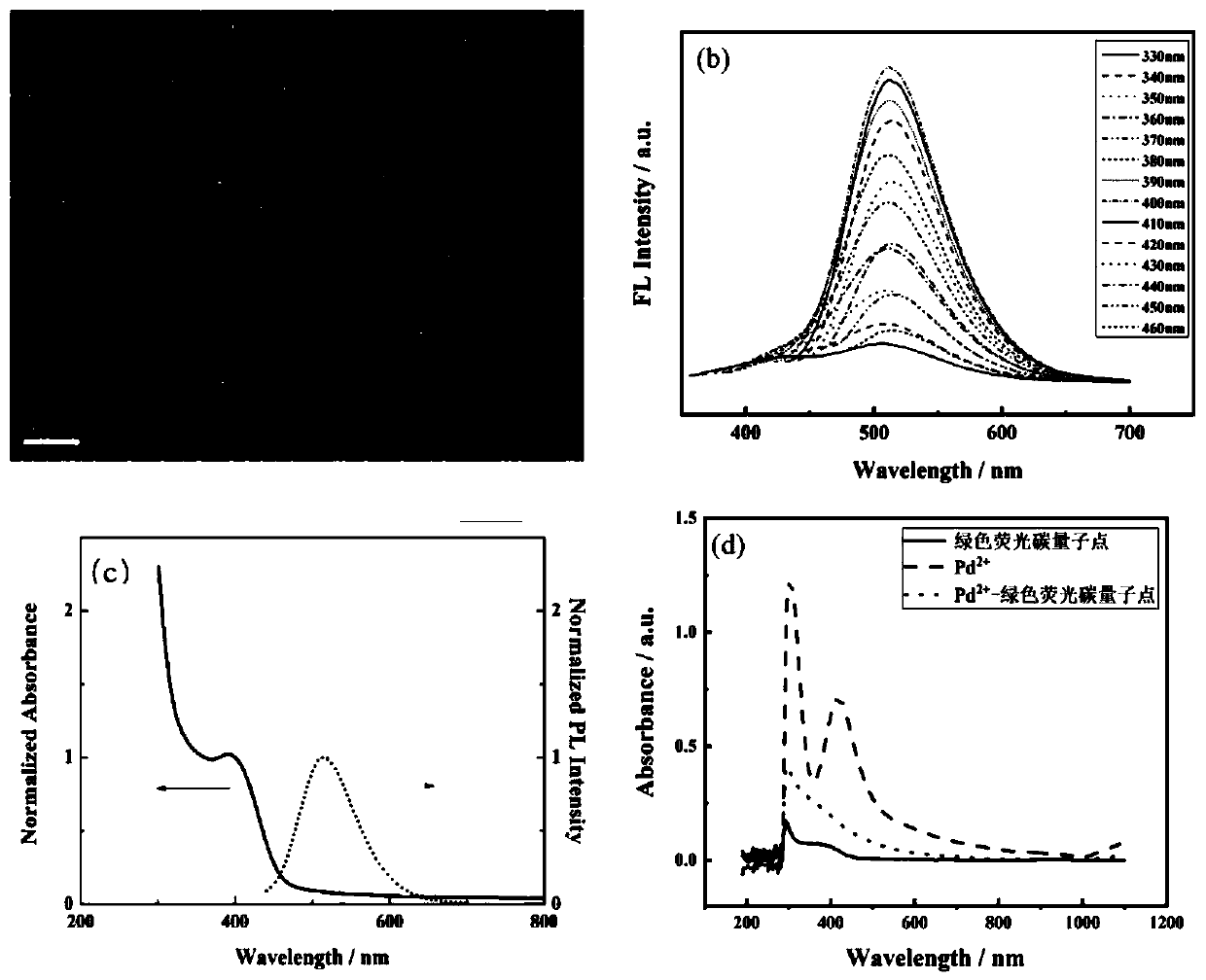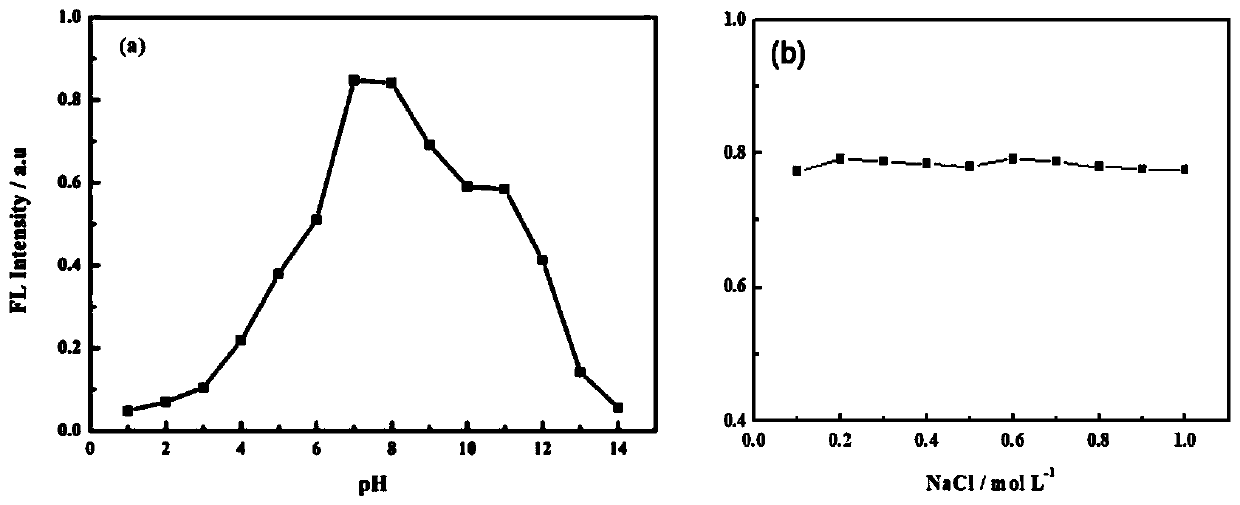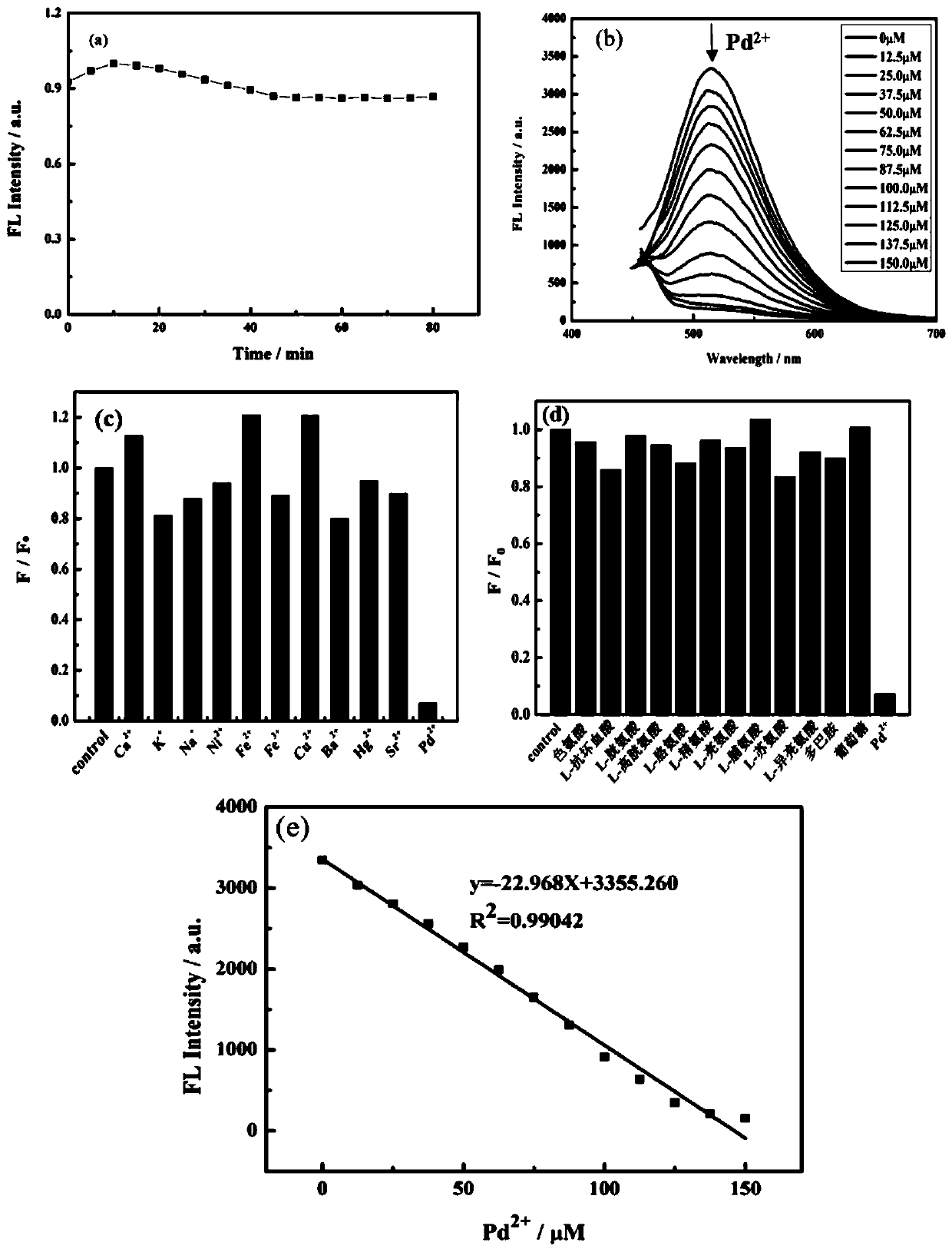Method for detecting palladium ion based on fluorescent carbon quantum dot
A technology of carbon quantum dots and green fluorescence, applied in fluorescence/phosphorescence, measuring devices, and material analysis through optical means, can solve the problems of high price and complicated operation, and achieve convenient operation, good water solubility, and short reaction time Effect
- Summary
- Abstract
- Description
- Claims
- Application Information
AI Technical Summary
Problems solved by technology
Method used
Image
Examples
Embodiment 1
[0028] 1. Preparation of green fluorescent carbon quantum dot materials (λ ex =400nm)
[0029] (1) Measure 40mL of distilled water and 7.2mL of ethylenediamine, mix them, then add 1mmol of DTNB, namely 5,5'-dithiobis(2-nitrobenzoic acid), and sonicate at room temperature Time 20min, ultrasonic power 100W, the solution turns from colorless to deep red;
[0030] (II) Put the above solution into the autoclave for carbonization, the temperature is set to 200°C, the pressure is 1.5MPa, the stirring speed is 370r / min, and the reaction time is 18h;
[0031] (III) Take out the solution obtained by carbonization, first filter it through a 0.22 μm canned needle filter, use a rotary evaporator to concentrate the filtrate to about 3-5 mL, and then pass it through a gel column (Shanghai Yuanye Biological Technology Co., Ltd. Technology Co., Ltd., Dextrose G-25 / Sephadex G-25) purification. The gel needs to be soaked in distilled water before use, and the upper layer of foam should be ski...
Embodiment 2
[0034] 1) use Na 2 HPO 4 12H 2 O and NaH 2 PO 4 2H 2 O and deionized water to prepare a PBS buffer solution with a pH of 1.0 to 14.0;
[0035] 2) Weigh 0.0400g of the solid green fluorescent carbon quantum dot material prepared in Example 1, dissolve it in 50.0mL of deionized water, and make a 0.8mg / mL solution;
[0036] 3) Pipette 0.2mL of the 0.8mg / mL solution, and then add the solution with a pH of 1 to 14 to 4.0mL, stir rapidly for 10s, transfer it into a cuvette, and record its fluorescence intensity with a fluorometer to obtain figure 2 (a).
[0037]4) Experiments found that when the pH is 7 or 8, the fluorescence intensity is greater. Then prepare PBS buffer solutions with pHs of 7.2, 7.4, 7.6, and 7.8, repeat the above operations, and measure the fluorescence intensity. It is found that when the pH=7.4, the fluorescence intensity of the solution is the highest.
[0038] 5) figure 2 (b) shows that the fluorescence of green fluorescent carbon quantum dots show...
Embodiment 3
[0040] 1) Prepare 0.8 mg / mL green fluorescent carbon quantum dot material solution. Weigh 0.0400 g of the solid green fluorescent carbon quantum dot material prepared in Example 1, dissolve it in 50.0 mL of PBS buffer solution with a pH of 7.4, and prepare a 0.8 mg / mL solution (as a mother solution).
[0041] 2) Take 0.2mL of the mother solution, dilute it to 4mL with PBS buffer solution with pH=7.4, stir rapidly for 10s, transfer it into a 4mL cuvette, put it into a fluorometer, record the fluorescence intensity at this time, and take it as 0min. Afterwards, record the fluorescence value every 10 minutes until 80 minutes, and get image 3 (a);
[0042] 3) Prepare 0.01M PdCl 2 solution. Take 0.2mL of the mother solution, dilute it to 4mL with PBS buffer solution with pH=7.4, stir rapidly for 10s, transfer it into a 4mL cuvette, and put it into a fluorometer to record the fluorescence intensity at this time. Then take 0.2mL of mother liquor, add 5, 10, 15, 20, 25, 30, 35, 4...
PUM
 Login to View More
Login to View More Abstract
Description
Claims
Application Information
 Login to View More
Login to View More - R&D
- Intellectual Property
- Life Sciences
- Materials
- Tech Scout
- Unparalleled Data Quality
- Higher Quality Content
- 60% Fewer Hallucinations
Browse by: Latest US Patents, China's latest patents, Technical Efficacy Thesaurus, Application Domain, Technology Topic, Popular Technical Reports.
© 2025 PatSnap. All rights reserved.Legal|Privacy policy|Modern Slavery Act Transparency Statement|Sitemap|About US| Contact US: help@patsnap.com



